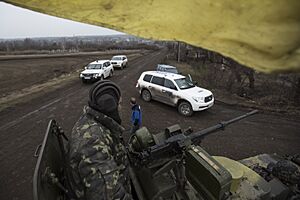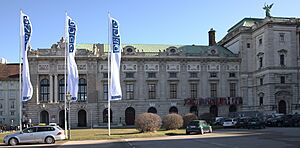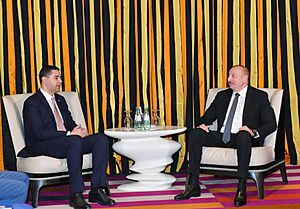Organization for Security and Co-operation in Europe facts for kids
Quick facts for kids
Organization for Security and Co-operation in Europe
|
|
|---|---|
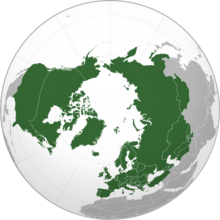 |
|
| Secretariat | Vienna, Austria |
| Official languages | English, French, German, Italian, Russian, Spanish |
| Type | Intergovernmental organization with no legal personality |
| Membership | 57 participating countries 11 partners for co-operation |
| Leaders | |
| Elina Valtonen | |
|
• Office for Democratic Institutions and Human Rights
|
Maria Telalian |
|
• Representative on Freedom of the Media
|
Jan Braathu |
| Establishment | |
|
• As the Conference on Security and Co-operation in Europe
|
July 1973 |
| 30 July – 1 August 1975 | |
|
• Paris Charter
|
21 November 1990 |
|
• Renamed OSCE
|
1 January 1995 |
| Area | |
|
• Total
|
55,511,860 km2 (21,433,250 sq mi) |
| Population | |
|
• 2024 estimate
|
1,304,525,088 (3rd) |
|
• Density
|
25/km2 (64.7/sq mi) |
| GDP (nominal) | 2024 estimate |
|
• Total
|
US$60.327 trillion |
|
• Per capita
|
US$46,245 |
The Organization for Security and Co-operation in Europe (OSCE) is a large group of countries working together for peace and safety. It includes countries from Europe, North America, and Asia. The OSCE helps with things like controlling weapons, protecting human rights, making sure the news is free, and holding fair elections.
It has about 3,460 people working for it. Most of them work in different countries, but some are at its main office in Vienna, Austria. The OSCE also works closely with the United Nations.
The OSCE started in 1975 during the Cold War. It was a place for countries from the Western and Eastern parts of the world to talk. Most of its 57 member countries are in Europe, but some are in Asia or North America. These countries cover a big part of the Northern Hemisphere.
The OSCE focuses on giving early warnings about problems. It helps prevent conflicts, manages crises, and helps countries rebuild after conflicts.
Contents
- How the OSCE Started
- What the OSCE Does: Missions and Operations
- OSCE Parliamentary Assembly
- Civil Society and Human Rights
- OSCE Members and Languages
- How the OSCE Works
- OSCE Structure and Leadership
- OSCE Field Operations
- OSCE Leadership: The Chairman-in-Office
- The Secretary General
- Important OSCE Meetings
- OSCE's Budget
- OSCE and the United Nations
- The Three Dimensions of OSCE Work
- OSCE Democracy Defender Award
- See also
How the OSCE Started
Early Ideas
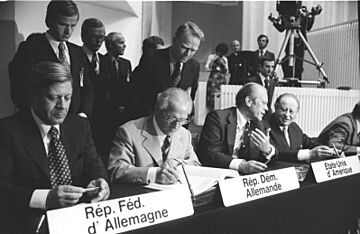
The OSCE began with the Conference on Security and Co-operation in Europe (CSCE) in 1975. People had talked about a European security group since the 1950s. But the Cold War made it hard to make progress.
Talks finally started in November 1972 in Espoo, Finland. The Soviet Union suggested these talks. They wanted to keep control over the communist countries in Eastern Europe. Finland's President, Urho Kekkonen, hosted the talks. He wanted to show Finland's neutral position. Western European countries saw these talks as a way to reduce tension. They also hoped to improve trade and human rights in the Eastern Bloc.
The ideas from these talks were put into "The Blue Book." This book set up a three-part conference called the "Helsinki process." The CSCE started in Helsinki on July 3, 1973. Thirty-five countries sent their representatives. The first part of the conference only took five days to agree on following the Blue Book. The second part was the main working phase. It happened in Geneva from September 18, 1973, to July 21, 1975.
The second part led to the Helsinki Final Act. Thirty-five countries signed this act during the third part of the conference. This took place in Finlandia Hall from July 30 to August 1, 1975.
After this, countries held follow-up meetings to improve relations. Major meetings happened in Belgrade (1977-1978), Madrid (1980-1983), and Vienna (1986-1989).
The Copenhagen commitment was an agreement about human rights. It said that people should be allowed to gather peacefully and form groups. This includes groups that work to protect human rights.
From CSCE to OSCE
The fall of the Soviet Union meant the CSCE needed a new role. The Charter of Paris for a New Europe, signed on November 21, 1990, started this change. The CSCE officially became the OSCE on January 1, 1995. This change happened after a meeting in Budapest in 1994.
The OSCE then got a formal office (secretariat) and other important groups. These included a Parliamentary Assembly and an Office for Free Elections. This office later became the Office for Democratic Institutions and Human Rights.
In December 1996, the "Lisbon Declaration" said that security in Europe is for everyone. It also said that security is connected across the continent.
In Istanbul on November 19, 1999, the OSCE held a meeting. They called for a peaceful solution in Chechnya. They also adopted a Charter for European Security.
The OSCE's Office for Democratic Institutions and Human Rights (ODIHR) watches elections in member countries. This helps make sure elections are fair and open. Between 1994 and 2004, the OSCE watched over 150 elections. In 2004, the ODIHR watched the US presidential election. This was the first time they monitored a US presidential election.
Challenges and Criticisms
Some OSCE members have criticized the organization. This is because countries like Russia and Belarus can stop decisions. For several years, Russia has blocked the OSCE's budget. It has also stopped official events and the extension of missions. In November 2023, Russia and Belarus blocked Estonia from being chairman in 2024.
What the OSCE Does: Missions and Operations
The OSCE sends missions to different countries to help.
Past Missions
- 1992 Georgia Mission: This mission started in November 1992 in Tbilisi. Its work ended on December 31, 2008. It could not stop the Russo-Georgian war in August 2008.
- 1998 Kosovo Mission: The OSCE Kosovo Verification Mission started in October 1998. It closed in June 1999 because of problems with the Milosevic government. The 1999 OSCE Mission in Kosovo then took over. It focuses on building institutions, democracy, and human rights.
- 2012 Texas Election: Before the US presidential elections in November 2012, the OSCE planned to send observers to Texas. The Attorney General of Texas, Greg Abbott, warned that OSCE officials could be arrested if they broke Texas law. The US State Department said OSCE observers had special protections. No problems happened during the elections.
- 2017 Turkey Constitutional Referendum: In April 2017, Turkish President Recep Tayyip Erdoğan criticized the OSCE. The OSCE reported that people campaigning against the referendum faced bans and arrests. Erdoğan said the OSCE should "know its place."
OSCE's Work in Ukraine (2014–2021)
On March 21, 2014, the OSCE sent its Special Monitoring Mission to Ukraine. Ukraine's government asked for this. The mission received mixed reviews. Some people praised it as the "eyes and ears of the international community." Others accused it of being biased towards Russia or Ukraine.
In April 2014, a group in Sloviansk took eight OSCE mission members hostage. During the war in Donbas, an OSCE observer allowed Russian separatists to use an OSCE vehicle. This led to accusations that the OSCE was biased. The organization said it regretted the incident.
The OSCE Observer Mission at Russian Checkpoints Gukovo and Donetsk also faced criticism. Only two checkpoints on the border were being watched. The US ambassador to the OSCE called this "seriously inadequate."
The mission was also criticized for being slow to use drones. Drones were used for a few weeks but then pulled back due to Russian electronic attacks. Drones were brought back in 2018.
In 2014, an advisor to Ukraine's Ministry of Defence wrongly claimed that most OSCE observers near Mariupol were Russian citizens. They also claimed many had ties to Russian security agencies. In reality, only one out of 17 observers in Mariupol was Russian. Overall, 39 out of 720 observers (5.4%) were Russian citizens. The organization was also accused of sharing Ukrainian troop locations with Russian forces.
In December 2014, the mission was near a power station to help with a ceasefire. They heard artillery fire and left for safety. No observer was wounded.
In October 2015, a suspended OSCE monitor admitted he was a former Russian intelligence officer. He said it was easy to get the job and his background was not checked well. The OSCE said he was fired for breaking their rules.
In April 2016, photos showed OSCE monitors at a Russian separatist wedding in June 2015. The OSCE regretted this "unprofessional behavior." They said the monitors were no longer with the mission.
In April 2017, an OSCE vehicle hit a mine near Luhansk. One American paramedic died, and two others were injured.
In July 2018, a German broadcaster reported that Russian intelligence got secret information about the OSCE mission in Ukraine. This information included details about observers' preferences and finances. The OSCE was concerned about this security breach.
Russia accused mission members of working for Ukraine's security service and spying on separatists. Russia also said the mission was biased. They claimed it reported on separatist troop movements but ignored similar moves by Ukraine. Russia's foreign minister also said the mission did not focus enough on human rights in Ukrainian-controlled areas. He also criticized the mission for not clearly saying who was breaking ceasefires.
OSCE's Work in Ukraine (2022–Present)
The 2022 Russian invasion of Ukraine started on February 24. The OSCE's mission in Ukraine ended on March 31, 2022, because Russia objected. On April 24, 2022, the OSCE protested the detention of four staff members in Donetsk and Luhansk. On September 20, two Ukrainian OSCE staff members were sentenced to 13 years in prison. A court in the Luhansk People's Republic accused them of "high treason and espionage for the United States."
In March 2022, 45 countries asked for an expert mission to investigate violations in the war. This mission's report in April 2022 found clear patterns of international law violations by Russian forces in Ukraine. The OSCE continues to monitor these violations.
In June 2022, the same 45 countries asked for a new expert mission. Its report in July 2022 confirmed the earlier findings. It found serious violations of international law and human rights, mainly by Russian forces.
The Russian delegation was not invited to the OSCE meeting in December 2022. Delegates discussed the war's impact and Russia's responsibility for damages.
Since the invasion, Russia has seized OSCE vehicles worth €2.7 million. These were from the Special Monitoring Mission to Ukraine. Russia claimed these vehicles were "evidence" and started criminal cases against former OSCE staff for espionage.
Recent Missions
- 2022 Mission to Armenia: An OSCE team was sent to Armenia from October 21-27, 2022. This was after the Armenia–Azerbaijan border crisis. Armenia's government asked for this. The OSCE sent experts to monitor the border.
OSCE Parliamentary Assembly
The OSCE Parliamentary Assembly is a group of lawmakers from member countries. In 2004, they sent observers to the US presidential elections. The president of the Assembly at that time was Alcee Hastings. He had faced criticism in the past. Some people criticized the OSCE for this, saying it showed bias.
In 2010, the Parliamentary Assembly faced criticism from within. The Latvian group said it lacked openness and democracy. The secretary general, R. Spencer Oliver, had been in his role since 1992. The rules made it very hard to replace him. A Latvian politician, Artis Pabriks, called these rules "quite shocking" for an organization that watches elections.
Civil Society and Human Rights
The Organization for Security and Co-operation in Europe (OSCE) holds the Human Dimension Conference. This is an important meeting about human rights, democracy, and the rule of law. Groups called Civil Society Organizations (CSOs) play a key role. They share their knowledge, raise awareness, and speak up for basic freedoms.
CSOs can attend meetings, submit statements, and organize their own events. They talk about human rights problems and challenges to democracy. Their presence helps bring attention to human rights issues. It also makes sure that the voices of people on the ground are heard.
To attend the conference, CSOs must register. The OSCE Office for Democratic Institutions and Human Rights (ODIHR) handles this. They provide all the information needed, including how to apply and deadlines. You can find details on the OSCE's official website. For the 2024 Human Dimension Conference, information is at: https://www.osce.org/chairmanship/2024WHDC
OSCE Members and Languages
Official Languages
The OSCE has six official languages: English, French, German, Italian, Spanish, and Russian.
Participating Countries
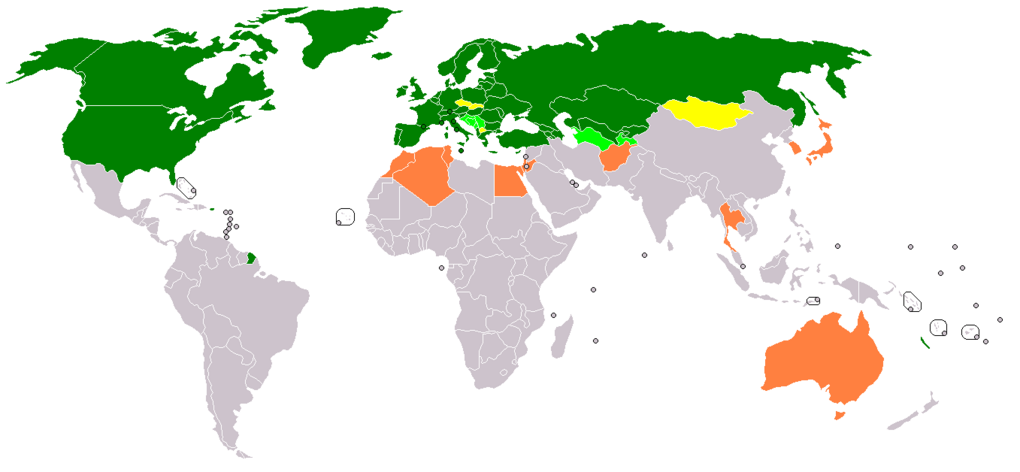
The OSCE has 57 participating countries. These countries have agreed to follow the OSCE's principles.
Partners for Co-operation
The OSCE also works with "Partners for Co-operation." These are countries that are not full members but work with the OSCE on shared goals.
- Middle East and North Africa States
- Asia
- Japan (since 1992)
- South Korea (since 1994)
- Thailand (since 2000)
- Afghanistan (2003–2021)
- Oceania
- Australia (since 2009)
How the OSCE Works
The OSCE is special because its main agreement, the Helsinki Final Act, is not a formal treaty. It's a political promise by leaders to work for security and cooperation. This makes the OSCE flexible. It can adapt and improve cooperation without getting stuck in legal arguments.
By signing, countries agreed that how they treat their own citizens is an international concern. This open approach helped build democracy in the Soviet Union and Eastern Europe. It also helped end the Cold War. The OSCE does not have international legal status like some other groups. So, Austria, where its main office is, had to give it legal status to sign agreements.
OSCE Structure and Leadership
Leaders of countries give the OSCE its main direction during summits. These meetings happen when needed. The last summit was in Astana, Kazakhstan, in December 2010. The OSCE Ministerial Council is the top decision-making body. It meets at the end of each year. The OSCE Permanent Council meets weekly in Vienna. It handles regular talks and decisions. The country holding the OSCE chairmanship leads the Permanent Council.
The Forum for Security Co-operation also makes decisions. It deals with military cooperation, like rules for inspections.
The OSCE's main office (Secretariat) is in Vienna, Austria. It also has offices in other cities like Copenhagen, Geneva, and Warsaw.
As of October 2021, the OSCE had 3,568 staff members. Most of them worked in its 17 field operations.
The Parliamentary Assembly of the Organization for Security and Co-operation in Europe has 323 lawmakers from 57 member countries. This Assembly passes resolutions on political, economic, and human rights issues. These resolutions encourage countries to keep their OSCE promises. The Assembly also works on diplomacy and observes many elections.
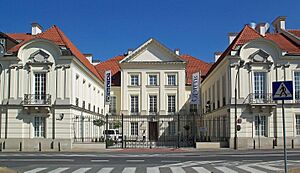
The oldest OSCE group is the Office for Democratic Institutions and Human Rights (ODIHR). It started in 1991 and is based in Warsaw, Poland. It works on election observation, democracy, human rights, and fighting discrimination. The ODIHR has watched over 300 elections since 1995. It has sent over 50,000 observers.
The Office of the OSCE Representative on Freedom of the Media started in December 1997. It acts as a watchdog for violations of freedom of expression in member countries. It also helps countries follow OSCE rules on free media.
The High Commissioner on National Minorities was created in July 1992. Its job is to find and solve ethnic tensions early. This helps prevent conflicts that could harm peace.
The OSCE also holds an annual Asian Conference with partner nations. These include Australia, Thailand, South Korea, and Japan.
In 2002, the OSCE and the government of Kyrgyzstan started the OSCE Academy. Its goal is to promote cooperation, prevent conflict, and encourage good governance in Central Asia.
OSCE Field Operations
Most OSCE field operations have been in countries of former Yugoslavia and the former Soviet Union.
Active Missions
The OSCE currently has several active missions:
- Presence in Albania (since 1999)
- Mission to Bosnia and Herzegovina (since 1995, related to the Dayton Agreement)
- Mission in Kosovo (since 1999, related to the Kosovo Conflict)
- Mission to Montenegro (since 2006)
- Mission to Serbia (since 2001)
- Mission to Skopje in North Macedonia (since 2001, related to the Ohrid Agreement (2001))
- Mission to Moldova (since 1992, related to the Transnistria conflict)
- Centre in Ashgabat, Turkmenistan (since 1999)
- Programme Office in Astana, Kazakhstan (since 1998)
- Programme Office in Bishkek, Kyrgyzstan (since 1998)
- Programme Office in Dushanbe, Tajikistan (since 1994)
- Project Co-ordinator in Uzbekistan (since 1995)
- Personal Representative of the Chairman-in-Office on the Conflict Dealt with by the OSCE Minsk Conference (since 1995, related to the Nagorno-Karabakh conflict)
Completed Missions
Many OSCE missions have finished their work:
- Missions of Long Duration in Kosovo, Sandjak, and Vojvodina (1992-1993, related to the Yugoslav wars)
- Mission to Georgia (1992-2008)
- Mission to Estonia (1993-2001)
- Mission to Latvia (1993-2001)
- Mission to Ukraine (1994-1999)
- Assistance Group to Chechnya (1995-1998, related to the First Chechen War)
- Mission to Croatia (1996-2012, related to the Croatian War of Independence)
- Kosovo Verification Mission (1998-1999, related to the Kosovo conflict)
- Office in Yerevan, Armenia (2000-2017)
- Office in Baku, Azerbaijan (2000-2015)
- Office in Minsk, Belarus (2003-2011)
- Observer Mission at the Russian Checkpoints Gukovo and Donetsk (2014-2021)
- Special Monitoring Mission to Ukraine (2014-2022, related to the Russo-Ukrainian war)
- Project Co-ordinator in Ukraine (1999-2022)
- Needs Assessment Team in Armenia (October 2022, related to the Nagorno-Karabakh conflict)
OSCE Leadership: The Chairman-in-Office
Each year, a different member country takes on the OSCE chairmanship. The foreign minister of that country becomes the OSCE's top leader, called the Chairman-in-Office (CiO).
The CiO's jobs include:
- Coordinating the work of OSCE groups.
- Representing the OSCE to the world.
- Overseeing efforts to prevent conflicts, manage crises, and help countries recover after conflicts.
The CiO gets help from the previous and next chairmen. These three together are called the OSCE Troika. The CiO also chooses special representatives who are experts in important areas. This role was formally set up in 1992.
For 2025, Finland holds the chairmanship, with Elina Valtonen as the Chairman-in-Office.
History of Chairmanship
The OSCE chairmanship rotates among member states each year. The foreign minister of that state serves as the Chairman-in-Office. Estonia was supposed to be chairman in 2024, but Russia and Belarus objected. Malta took over the chairmanship for 2024.
| Year | Country | Chairman-in-Office |
|---|---|---|
| 2020 | Edi Rama | |
| 2021 | Ann Linde | |
| 2022 | Zbigniew Rau | |
| 2023 | Bujar Osmani | |
| 2024 | Ian Borg | |
| 2025 | Elina Valtonen |
The Secretary General
The Chairman-in-Office is the top official, but the Secretary General manages the OSCE day-to-day. The Secretary General can also represent the Chairman-in-Office if asked. Since the role started in 1992, the Secretaries General have been:
| Secretary General | Country | Term of office |
|---|---|---|
| Wilhelm Höynck | 1993–1996 | |
| Giancarlo Aragona | 1996–1999 | |
| Ján Kubiš | 1999–2005 | |
| Marc Perrin de Brichambaut | 2005–2011 | |
| Lamberto Zannier | 2011–2017 | |
| Thomas Greminger | 2017–2020 | |
| Helga Schmid | 2020–2024 | |
| Feridun Sinirlioğlu | 2024– |
Important OSCE Meetings
Summits of Leaders
These are meetings of heads of state or government.
| Summit | Date | Location | Country | Key Decisions |
|---|---|---|---|---|
| I | July 30 – August 1, 1975 | Helsinki | The Conference on Security and Cooperation in Europe (CSCE) closed. The Final Act (Helsinki Act) was signed. | |
| II | November 19–21, 1990 | Paris | The Paris Charter for a New Europe was signed. Other important agreements on arms control were also made. | |
| III | July 9–10, 1992 | Helsinki | The High Commissioner on National Minorities and other groups were created. | |
| IV | December 5–6, 1994 | Budapest | A multinational peacekeeping force for Nagorno-Karabakh was approved. | |
| V | December 2–3, 1996 | Lisbon | The "Lisbon Declaration" on security in Europe was adopted. | |
| VI | November 18–19, 1999 | Istanbul | The Istanbul Document and the Charter for European Security were signed. | |
| VII | December 1–2, 2010 | Astana | The Astana Commemorative Declaration was adopted. It confirmed the OSCE's broad approach to security. |
Ministerial Council Meetings
These are regular meetings of foreign ministers from member countries.
| Council | Date | Location | Country | Key Decisions |
|---|---|---|---|---|
| 29th | December 1–2, 2022 | Łódź | Russia was not invited due to its invasion of Ukraine. There were calls to assess what Russia should pay for damages. | |
| 30th | November 29 – December 1, 2023 | Skopje | ||
| 31st | December 5–6, 2024 | Valetta | ||
| 32nd | 2025 | Helsinki |
OSCE's Budget
The OSCE's budget helps fund its operations and missions.
OSCE and the United Nations
The OSCE sees itself as a regional organization that works with the United Nations. It is an observer at the United Nations General Assembly. The Chairman-in-Office regularly updates the United Nations Security Council.
The Three Dimensions of OSCE Work
The OSCE's work is divided into three main areas, or "dimensions," to cover all aspects of security.
Politico-Military Dimension: Keeping Peace and Safety
This dimension focuses on military security and preventing conflicts. The OSCE helps countries work together and be more open about their military activities.
- Controlling Weapons: After the Cold War, many extra weapons became available. The OSCE helps stop the illegal spread of these weapons. It also helps destroy them. The OSCE hosts annual information exchanges about weapons.
- Border Management: The OSCE helps monitor borders. This includes preventing conflicts, managing crises, and supporting border control.
- Fighting Terrorism: The OSCE uses its experience in preventing conflicts and managing crises to help fight terrorism worldwide.
- Preventing Conflicts: The OSCE works to stop conflicts before they start. It also helps find lasting political solutions for ongoing conflicts. It supports rebuilding efforts in areas after conflicts.
- Military Reform: The OSCE provides a way for countries to talk about changing their military systems. Its field operations also carry out practical activities.
- Policing: OSCE police operations are a key part of its efforts to prevent conflicts and help rebuild after them.
- Putting Plans into Action: The OSCE became a larger organization when it was chosen to help organize elections in Bosnia and Herzegovina in 1996. It helped set up elections, human rights efforts, and legal systems there. The OSCE took over some roles from the United Nations in Bosnia and Herzegovina. This was because Bosnian leaders felt the UN had not done enough to stop the war. The OSCE continues to work for lasting peace in the region.
Economic and Environmental Dimension: A Healthy Planet and Economy
This area focuses on how economic and environmental issues affect security. The OSCE watches for threats and helps countries create policies to improve security.
- Economic Activities: The OSCE works on things like managing migration, transport, and energy security. It often works with other organizations on these activities.
- Environmental Activities: The OSCE has many projects to deal with environmental threats to security. This includes work on hazardous waste, water management, and access to environmental information.
Human Dimension: Protecting People's Rights
This dimension is about making sure human rights and basic freedoms are respected. It also promotes the rule of law and democracy.
- Fighting Human Trafficking: Since 2003, the OSCE has worked to fight human trafficking. This means raising awareness and encouraging countries to stop it. The Office of the Special Representative and Co-ordinator for Combating Trafficking in Human Beings leads these efforts.
- Promoting Democracy: The OSCE aims to promote democracy. It helps countries build and strengthen democratic systems.
- Education: Education programs are important for preventing conflicts and rebuilding after them.
- Elections: The OSCE helps with elections to promote democracy. However, some question how effective this help is. For example, Kazakhstan, a former OSCE chair, is seen by many as not very democratic.
- Gender Equality: The OSCE works to ensure equal opportunities for men and women. It aims to include gender equality in all policies.
- Human Rights: The OSCE focuses on human rights like freedom of movement and religion. It also works to prevent torture and human trafficking.
- Media Freedom: The OSCE watches media developments in member countries. It provides early warnings about violations of freedom of expression.
- Minority Rights: Ethnic conflict is a major source of violence. The OSCE works to identify and solve ethnic tensions early. It also sets standards for the rights of minority groups. The High Commissioner on National Minorities was created for this purpose.
OSCE Democracy Defender Award
The Democracy Defender Award honors people or groups who help promote democracy and human rights. The award started in 2016.
| Year | Recipient | Nationality | Notes | |
|---|---|---|---|---|
| 2022 | ZMINA Memorial |
Ukrainian Human Rights Centre Zmina and to the Russian Memorial Human Rights Centre in recognition of their courageous and important efforts to promote human rights and democracy. | ||
| 2020 | Viasna Human Rights Centre | Belarusian organization established in 1996 which advocates for the rights of political prisoners in Belarus and against the government of Alexander Lukashenko. | ||
| 2019 | Union of Informed Citizens (UIC) | Armenian organization which intends to raise public awareness on important issues and reduce the impact of misinformation on decision-making. | ||
| 2018 | CRTA | Serbian organization established in 2002 to improve the democratic culture, the rule of law and the freedom of the Media | ||
| 2017 | Golos | Russian organization established in 2000 to protect the electoral rights of citizens and to foster civil society | ||
| 2016 | Oleksandra Matviychuk | Ukrainian activist, coordinator of Euromaidan SOS and leader of Civil Rights Center |
See also
 In Spanish: Organización para la Seguridad y la Cooperación en Europa para niños
In Spanish: Organización para la Seguridad y la Cooperación en Europa para niños



